For English version please scroll down.
Se suele decir que la India o te enamora o la odias, veremos como acabará para nosotros después de un mes viajando por ella.
Lo primero que necesitas para viajar a India es un visado, en los últimos años el gobierno indio está fomentando más el turismo y para eso a implementado el visado electrónico. El cual te da la ventaja de ser de doble entrada (para la entrada solo se admite para viajes en avión, pero para salir puede ser por tierra) y dura 90 días. El sistema es bastante sencillo, sólo te tienes que registrar en la página web, subir una copia escaneada del pasaporte (que sea visible) y una foto con las medidas que te piden. Si todo va bien en un día lo tienes listo.
Desde Amman conseguimos un vuelo barato con Bahrein airlines, hacia Mumbai y con escala en Bahrein. Lo bueno de tener tiempo para viajar es que puedes coger aviones a horas intempestivas para ahorrar bastante, el problema, pues eso que los horarios no son los mejores. En nuestro caso llegamos a las cinco de la mañana hora local, la una y media en España. Una vez pasado los trámites del pasaporte y cogido nuestro equipaje nos fuimos al hall a buscar un sitio donde echar una cabezadita con la suerte de encontrar unos sofás.
Ya descansados nos fuimos a sacar dinero del cajero y a buscar un taxi. Esta vez escogimos un taxi prepagado que había a disposición en el aeropuerto. En estos taxis pagas una tarifa preestablecida dependiendo a donde vayas, para eso lo contratas en la taquilla y te dan un ticket que le darás al taxista una vez te haya llevado al destino y así el puede cobrar el trayecto. Lo bueno de este sistema es que sabes que no te van a tomar y te va a llevar directo sin rodeos ya que le interesa volver a buscar a más viajeros, lo malo es que ya te han timado porque pagas más que un taxi con taxímetro.
Nuestro hotel se encontraba en la zona musulmana de Mumbai. Cuando llegamos a la misma todos los esteriotipos de la India que teníamos en mente se convirtieron en realidad. Aunque no vamos a entrar a hablar de ellos. Una cosa que nos resultó chocante fueron los precios de los alojamientos en India, en booking y en otros sitios no pudimos encontrar nada a precios «indios» y todos eran más parecidos a precios «europeos», pero con una calidad que se alejaba un poco del precio por el cual estabas pagando.
Cómo aún estábamos tocados por la noche en el avión y cambio horario nos fuimos a dormir tan pronto como llegamos. Cuando estábamos medio dormido nos llaman a la puerta de la habitación para darnos la clave del WIFI, con el sueño que traíamos no estábamos para ver internet. Lo cogimos y volvimos a la cama, pero a los 5 minutos vuelven a llamarnos el personal para darnos un rollo de papel higiénico… Ya con los ánimos un poco encendidos le dije que no nos volvieran a molestar. Y ya si pudimos irnos a dormir.
Más tardes ya un poco más frescos fuimos a la estación de trenes para ir a comprar nuestro billete con dirección a Udaipur. De camino empezó a llover a cántaros así que después de pasar un rato debajo de un edificio y ver que no paraba fuimos a comer a un restaurante que se encontraba al otro lado de la calle.
Para aquellos que no hayan estado en algún país asiático o en algunos árabes, cruzar la calle puede parecer imposible porque por mucho que esperes nadie va a parar, y nosotros estábamos en una de las vías principales así que el tráfico no iba a aminorarse. Pero es tan fácil como cruzar la calle y ellos te van esquivando, eso si no te metas delante de los que van acelerados que esos no paran. De todos los sitios con tráfico similar en los cuales hemos estado en el pasado, esta calle fue de las peores, ni el tráfico en China, Mongolia, Sri Lanka, Marruecos, Jordania o la parte asiática de Rusia se podían comparar con cruzar aquella calle. Aunque más tarde ya estábamos acostumbrados. También huelga decir que en esta parte de la ciudad la parte más importante de un coche no es el volante o el freno, ni siquiera el airbag (que muchos dudo que poseyeran) si no el claxon. Cada dos segundos un conductor tenía que tocarlo, y eso multiplicado por todos los conductores de esa avenida se hacía un poco demasiado insufrible al principio, para poco a poco acostumbrarte y finalmente ya lo ignoras porque muchas veces pitaban sin ningún motivo.
En el restaurante éramos los únicos extranjeros y todos se quedaron viendo para nosotros. Si éramos los primeros en entrar allí lo dudo, ya que mucha gente en general se te queda mirando por la calle fijamente como si tuvieras un pulpo por sombrero. Pero en fin con el tiempo nos acostumbraríamos, pensamos. Pedimos para comer nuestros primeros curries en India y estaban muy buenos, nada que ver con lo que se come por Europa.
La lluvia parecía amainar cuando salimos del restaurante así que continuamos en dirección a la estación de trenes, pero en nuestro camino volvió a comenzar de nuevo a llover, el monzón todavía no había acabado. Nos llevó casi dos horas llegar a la estación, sin contar la comida, para un recorrido que no se tarda más de media hora.
La estación de trenes Chatrapathi Shivaji, se encuentra en un hermoso edificio de la época colonial británica. En India los extranjeros tienen una ventanilla especial para ir a comprar los billetes y dependiendo donde estés solo la puedes comprar en ese sitio designado. Dicho esto nos metimos en la estación y aquello parecía el primer día de rebajas, de la gente que había. Sin querer habíamos llegado a la hora de la salida de los trabajos y mucha gente se iba en el cercanías de vuelta a casa. La primera gran tarea fue encontrar la taquilla específica para nosotros dentro de la algarabía producida por el fin de la jornada laboral que había en esos momentos. Tuvimos que preguntar a varios agentes casi en cada paso para poder orientarnos, ya que la taquilla está un poco escondida. Se encuentra en unas oficinas en la parte exterior de la estación en el segundo piso y no junto a las otras taquillas de uso inmediato. Cuando finalmente llegamos y quisimos compar los billetes ya no quedaban para la fecha que queríamos, pero por suerte el responsable nos dijo que volvieramos al día siguiente ya que se iban a liberar plazas y podríamos comprarlo con el sistema «Tatkal».
El sistema de compras de trenes indio es un «poco complicado» ya que cuando todo parece que está reservado siempre ahí opciones de conseguir billete… Que si tienes billetes de cuota de turistas, billetes Taktal, billetes contra reserva de cancelación, billetes en lista de espera… Toda una pequeña constelación de opciones para poder perderse, así que, en estos casos, cuando a trenes se refiere nada mejor que ir a la página de man in seat 6. La mejor que conozco para explicar los sitemas de trenes por el mundo, así que para aquellos interesados en saber como funciona aquí la tenéis.
Pues bién al final toda la mojadura y las horas de espera habían sido infructuosas. Como no paraba de llover volvimos a la habitación del hotel para ducharnos y cambiarnos y relajarnos viendo alguna película en el ordenador.
Al día siguiente fuimos a primera hora a comprar los billetes, aunque no conseguimos comprar la clase que queríamos 3A, conseguimos uno en la clase sleeper. La diferencia con el que queríamos es que la clase sleeper no tiene aire acondicionado, es de cama dura, no te dan sabanas ni almohadas. O lo que es lo mismo es una clase más barata a la 3A, pero al menos teníamos una cama donde dormir y salíamos el día que queríamos.
Ya con los billetes comprados, nos fuimos a ver el centro, ese día era el 15 de Agosto y se conmemoraba el aniversario de los 70 años de la independecia de India. Hecho que se notaba en las calles ya que estaban más vacias de coches y mucha gente estaban subidos a varios camiones celebrandolo con música y bailando/saltando dentro de los mismos.
Tan pronto pasas de la estación de tren con dirección sur hacia la zona colonial. Empieza a haber un gran cambio en el «paisaje» para empezar empiezas a notar como el número de coches se empieza a reducir por esa área y lo que más se agradece es que empate debido a esto y en parte debido a la prohibición, el nivel de coches tocando el claxon se reduce considerablemente, aparecen aceras que no había en otras partes. Que realmente resultaba como entrar en un mundo diferente del que habíamos vivido el día anterior. Fuimos en dirección a la llamada «puerta de la India» por el camino se pueden apreciar hermosos ejemplos arquitectónicos de la época colonial.
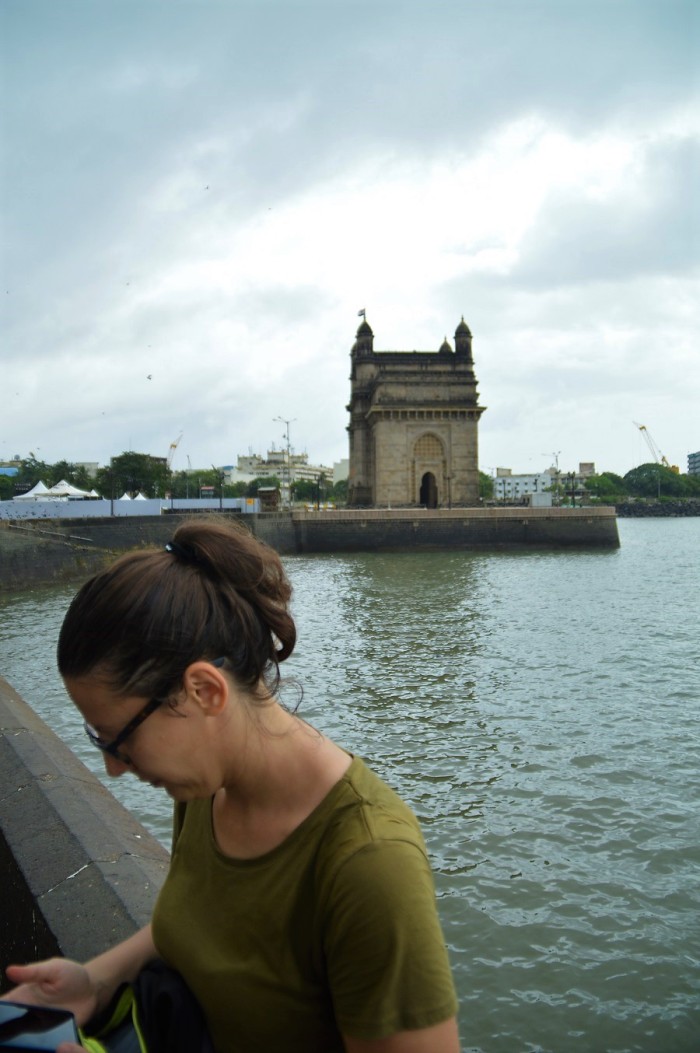
La puerta de India desde la bahíaIndian gateway from the bay
Cuando llegamos estaba cerrado para la ceremonia de independencia, así que fuimos paseando alrededor del lugar buscando un sitio para comer algo que estuviera abierto, por suerte encontramos uno que estaba abierto, aunque curiosamente tenía un guardia de seguridad controlando las mochilas, bolsos y demás. No sabemos si era por que era el día de la independencia o era algo normal para ese lugar aunque con aquellos precios no sabemos como se lo podrían permitir… Como estaba empezando a nublarse y no queríamos volver a acabar mojados hasta los huesos como el día anterior, empezamos a volver de nuevo al hotel, aunque esta vez volvimos por la marina y no por la calle principal. La cual era más tranquila para caminar y no había tanto coche.
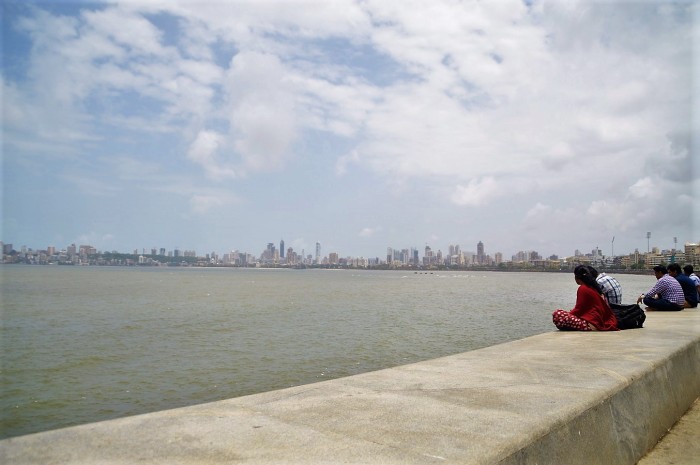
Vistas desde la marina – Views from the marina
Llegamos al hotel un poco después de que comenzara a llover con la suerte de que esta vez no nos habíamos mojado tanto. Pasamos la tarde planeando nuestro viaje por India y viendo el capitulo de Juego de Tronos. Cuando la lluvia ya comenzaba a parar fuimos a comer algo por la zona, por suerte había varios restaurantes ya que vistas las condiciones de la comida callejera mejor no arriesgábamos para coger la belly Delhi (diarrea). Más tarde una vez pasadas las lluvias salimos a recorrer la zona musulmana donde estábamos.
Al día siguiente volvimos al centro esta vez para poder entrar en los sitios, y además hacia buen tiempo y el Sol estaba fuera. Esta vez sí que pudimos entrar cerca de la puerta de la India, que estaba abarrotada de gente, y de mucho pesado fotógrafo que te ofrecía sus servicios.
Aunque solo llevábamos tres días en India, ya nos apetecía algo no picante y acabamos esta vez en un Subway. Si, vergüenza para nosotros, aunque esperamos que sea la primera y última vez en este viaje. Una vez comidos nos fuimos a ver el museo de Chhatrapati Shiwaji Maharaj Vastu Sangrhalaya, (os juro que no me he inventado el nombre), aunque cuando llegamos allí empezamos a notar como se tratan a los turistas en India en temas de precios. Generalmente existen tres precios para la gente de India que costaba 85 rupias (más o menos un euro), para la gente perteneciente al SAARC (algo así como la UE pero para el Sur de Asia) que suele ser la mitad que para los extranjeros, y por último la entrada para extranjeros que costaba 500 rupias (más o menos seis euros y medio). Es decir que nos querían cobrar 6 veces más y en este caso este museo es principalmente sobre arte Europeo, con solo una parte pequeña dedicada al arte colonial. Así pues visto el sablazo y teniendo en cuenta que no habíamos viajado desde Europa para ver más arte Europeo en la India, pues ahí dejamos plantado al museo. A la vuelta volvimos por la zona del puerto ya que queríamos buscar el otro puerto de embarque para ir a la isla Elefante para visitar sus cuevas. Tuvimos la tan buena suerte que de nuevo nos empezó a llover a cántaros por el camino y sin apenas sitios donde refugiarnos de ella. Que maravilla el monzón, por lo menos no tuvimos las inundaciones que había afectado a Mumbai la semana previa a nuestra llegada.
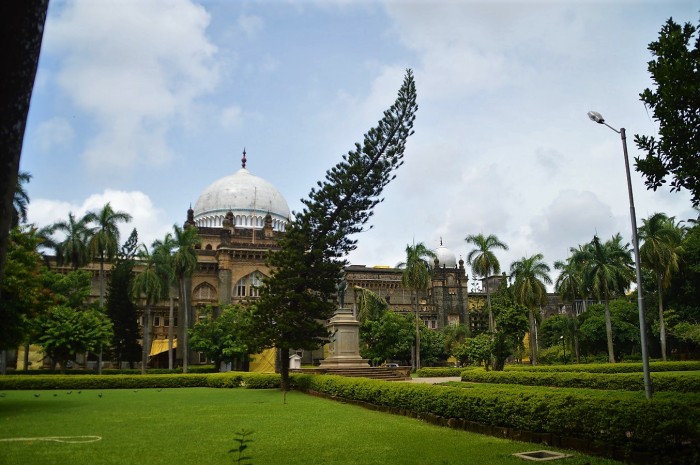
Chhatrapati Shivaji Maharaj Vastu Sangrhalaya Museo
Así que otra vez mojados volvimos al hotel, y dejamos la investigación de la isla Elefanta. Al día siguiente, y último día en Mumbai, iríamos a la isla pero desde la puerta de India. La cual sabíamos fijo que salían barcos hacia la isla. Los billetes cuestan unos 5 euros ida y vuelta. Lo que nos resultó curioso fue que cuando abordamos el barco quisimos subir encima de la cubierta, nos pararon y dijeron que para ir arriba teníamos que pagar más. A lo cual viendo la cantidad de sitio que teníamos donde estábamos reusamos pagar más. No era mucho la diferencia pero ya teníamos la mosca en la oreja de que como nos descuidaramos íbamos a pagar hasta por respirar. Aunque finalmente comprobamos que no era sólo para extranjeros y también le pedían más a la gente local. El recorrido a la isla lleva casi una hora durante todo ese tiempo vas pasando por la costa de Mumbai, donde puedes ver uno de sus puertos militares, la construcción de la zona nueva, y más a lo lejos parte de las colinas que rodean la peninsula.
Nuestra suerte con la lluvia nos seguía y nada más desembarcar empezó a llover con fuerza. Por suerte las escaleras que llevan al templo están cubiertas con toldos que los vendedores tenían puestos para cubrir su mercancía. así que al menos no nos mojamos. Como no paraba de llover, nos detuvimos a comer algo en uno de los puestos / «restaurantes» que hay a lo largo de la subida, mientras estabamos comiendo vimos a mucha gente que había subido hacia las cuevas que ya estaban bajando pasados pocos minutos, algo que nos sorprendió ya que los habíamos visto entrar en el recinto. Cuando llegamos a la taquilla de nuevo nos encontramos con la diferencia de precios 30 rupias la gente local y 500 los extranjeros. Como esto tenía pinta que iba a ser así todo el tiempo fuimos a comprar las entradas, pero oh sorpresa de nuevo nuestra, no tenían para pagar con tarjetas de crédito y no teíamos suficiente dinero en efectivo suficiente. Lo más frustante es que los vendedores ambulantes locales si tenían para pagar con tarjeta de crédito y eso que ni siquieran tenían un puesto fijo. ¡País de contrastes! Al ver salir la gente tan rápido del lugar tampoco nos quedamos tan mal de perdernos algo tan grandioso, mucha gente se quedaba 10 minutos dentro y se iban, y mucho menos después de haber estado en Petra y en Göreme recientemente no creo que nos hubieran impresionado. Así que resignados usamos el tiempo para ir a ver un poco la isla. Aunque como el tiempo no daba señales de mejora, fuimos a ver el lago y después nos volvimos al barco. Ya habíamos hecho el check out y no nos hacia gracia acabar mojados durante el trayecto nocturno en el tren.
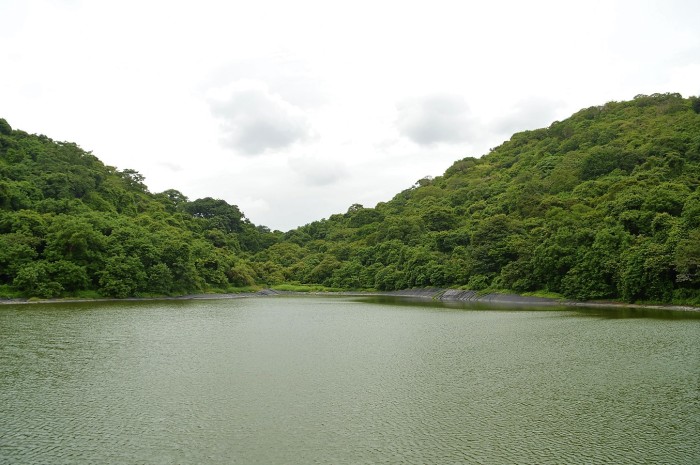
Lago en la isla Elefante – Lake in Elephant island
A la vuelta estuvimos caminando de nuevo por la zona colonial, antes de volver en dirección al hotel paramos para cenar algo. Desde nuestro hotel cogimos un taxi para ir a la estación de trenes de Bandra que queda cerca del aeropuerto. Esta vez cogimos un taxi con taximetro y nos salió mucho más barato que el de prepago. Habíamos estado cuatro días en Mumbai y la verdad es que ya teníamos ganas de irnos al Rajastan. Sinceramente si volvieramos a hacer esto no pasaríamos mas de dos días en Mumbai, ya que no hay mucho que visitar y nos llegó a ser una ciudad bastante extresante, cosa que el monzón no ayudo en nada a aminorar esa sensación.

Indian gateway

Catedral – Cathedral
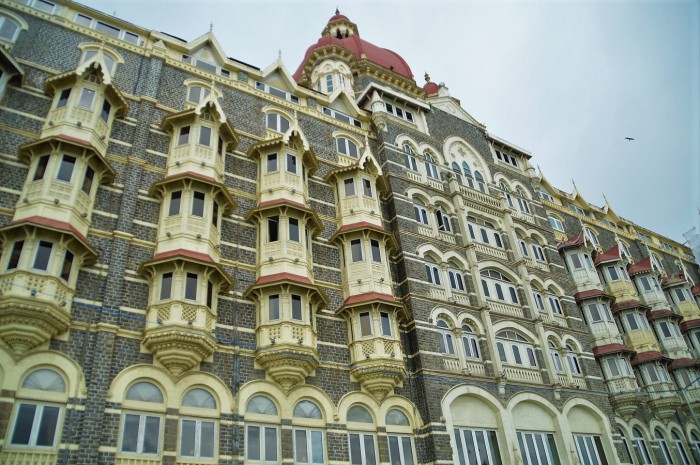
Hotel Taj Mahal

Estatua en el jardín del museo cuyo nombre no puedo pronunciar – Statue in the garden of the museum which name I am not able to pronounce

Torre del reloj – Clocktower
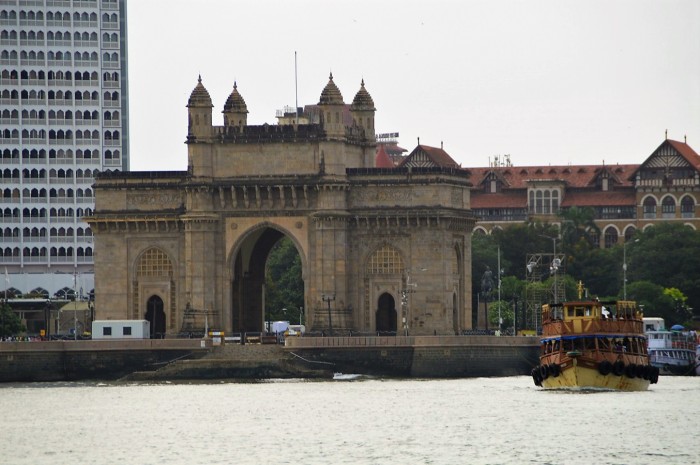
Volviendo de la isla Elefante – Coming back from Elephant island
They say that you either love or hate India, let´s see how we will feel after one month of travelling.
The first thing you need to go to India is a visa, in the last years the Indian government is trying to promote tourism and they have implemented the electronic visa. This has the advantage of being a double-entry visa (for the entry, this type of visa can be used only if you arrive by plane, but you can exit the country by land) and it is valid for 90 days. The system is quite simple, you just have to register on their website, upload a scan of your passport (a good quality one) and a picture, using the sizes they recommend. If everything goes well, the visa is granted in one day.
We found a cheap flight from Amman to Mumbai with Bahrain Airlines and a transfer in Bahrain. The good thing when you have time to travel is that you can find quite cheap flights and save a lot of money, the problem being that the times are not always the best. We arrived at 5 in the morning to Mumbai, 1:30 Spain time. After we passed the passport control and picked up our luggage, we went to the hall to find a place for a nap, hoping to find some sofas.
After resting for a while, we went to withdraw money and look for a taxi. This time we took one of the prepaid taxis that are available in the airport. For this type of taxi, you pay the amount according to your destination, at a special counter, where they give you a ticket that you will give to the driver once you arrive at your hotel and this way he can receive the money for the trip. The good thing about this system is that you know that they will take you directly to your destination, because they want to go back to the airport and pick up more passengers, the downside is that you pay more than what you´d pay for a metered taxi.
Our hotel was in the Muslim neighborhood of Mumbai. When we arrived there all our stereotypes about India became true. But we´re not going to talk about them. One thing that shocked us were the prices for accommodation in India, in Booking and other sites we did not find anything at an «Indian» rate, but more at a «European» rate, but not the best value for the money we were paying.
Since we were still tired after the night in the plane and the change of time, we went to sleep as soon as we arrived at the hotel. When we were almost asleep, they knocked on our door to give us the Wifi password, but we were so tired that this was the last thing on our mind. We took it and went back to bed, only to hear another knock 5 minutes later, this time to give us a toilet paper roll… Already a bit annoyed, I asked him not to bother us anymore. Finally we could go to sleep…
A bit later, already refreshed, we went to the train station to buy out tickets to Udaipur. On the way there it started to rain, so after spending some time under a building and seeing it that it would not stop, we went to eat at a restaurant across the street.
For those of you who have never been to an Asian country, or in some Arab countries, it can seem impossible to cross the street because nobody stops, no matter how long you wait, and we were on one of the main roads, so the traffic was not getting better. It is not that difficult to cross the street, because the motorbikes and the cars will avoid you; however, do not go in front of the ones that have high speed, because they will not stop. From all the countries with hectic traffic that we have visited so far, there wasn´t any as bad as this one; the traffic in China, Mongolia, Sri Lanka, Morocco, Jordan or the Asian part of Russia, none could compare to crossing that street. Although later we got used to it. We must mention that in this part of the city, the most important part of the car is not the steering wheel or the brake, not even the airbag (I doubt that many cars have it), but the horn. Every two seconds, a driver had to touch it, multiplying this with the number of drivers, it was a bit hard to handle in the beginning, but you get used to it after a while and in the end you just ignore it, because very often they honk without any reason at all.
We were the only foreigners in the restaurant and they were all staring at us. I doubt that we were the first ones to go there, it is just that in general, people stare at you on the street as if you have an octopus on your head. But anyway, we thought, we´ll get used to it with time. We asked our first curries in India, very tasty, nothing to do with what we are eating in Europe.
The rain seemed to stop when we went out of the restaurant so we continued to walk towards the train station, but it started again to rain, the monsoon was not over yet. It took us almost two hours to get to the train station, without counting the food, for a trip that should take half an hour.
The train station Chatrapathi Shivaji is in a beautiful building that dates from the British colonial times. In India, there is a special ticket counter for the foreigners and depending on the city, it can be the only place from where you can buy the tickets. This said, we went inside the train station, which looked like the first day of sales, judging by the amount of people that were there. Without wanting, we arrived at the rush hour, when people finish their work and they pick up the commuting train to go home. The first big task was to find the foreigners´counter in the madness produced by the end of the working day. We had to ask several people in order to orientate ourselves, given that the counter is a bit hidden. It is in a building on the exterior side of the train station, on the second floor and not next to the normal ticket counter. When we finally arrived there and wanted to buy the tickets, there weren´t any left for the day we wanted, but luckily the ticket seller told us to go back the following day because there will be some seats available and we could buy them through the system called «Tatkal».
The Indian train ticketing system is a «bit complicated» and when everything seems reserved, there are still options to buy the tickets… You have the tourist quota, the Tatkal tickets, the reservation against cancellation tickets, the waitlist tickets… A little mix of options that can make you feel lost, so, in this case, there is nothing better than checking the page of man in seat 61. This is the best site about trains around the world, so for those of you interested in knowing how it works, here you have the link.
In the end, getting wet in the rain and spending so much time on the way did not have any result. Since the rain hadn´t stop, we went back to the hotel to take a shower, change and relax watching a movie.
Next morning, the first thing we did was to go to buy the tickets; even if we did not get the ones for the 3A class, we got two for the sleeper class. The difference between these two is that the sleeper class does not have air conditioning, it has hard beds and they do not give you bed sheets, nor pillows. It is as well cheaper than the 3A class, but at least we had a bed and we were leaving the day we wanted.
After finally buying the tickets, we went to see the city center – that day was the 15th of August, when India celebrated its 70 years of independence. This was noticeable on the streets, there were not as many cars and many people were in trucks, where they were celebrating with music and dancing/jumping.
As soon as you pass the train station, going to the south towards the colonial area, you start to notice a change in the «landscape» – first, you notice how the number of cars gets lower and what you enjoy the most, partly due to the fact that they are forbidden, there is not so much honking, then, you start to see the sidewalks, that you haven´t seen before. This really felt like entering a completely different world than the one we had witnessed the day before. We walked towards the Gateway of India and on the way we could see beautiful architectural examples from the colonial times.

La puerta de India desde la bahíaIndian gateway from the bay
When we arrived there, the area was closed due to the ceremony for the Independence Day, so we just walked by it searching for a place to eat – we luckily found one that was open, although we found it strange that the guard was checking the backpacks, bags etc before going in. We´re not sure if it was because of the holiday or if it was something normal for this place, although with the prices they had, we are not sure how they could afford it… Since it was starting to get cloudy and we didn´t want to get wet again like the day before, we started walking towards our hotel. This time, we chose a different way, through the marina, and not going on the main street, because it was calmer and there were not so many cars.

Vistas desde la marina – Views from the marina
We arrived at the hotel a bit after it had started to rain, thinking we were lucky for not getting wet this time. We spent the afternoon planning our trip to India and watching an episode of Game of Thrones. When the rain stopped, we went to eat something in our area, luckily there were several restaurants there, because after seeing the cooking conditions of the street food, we did not want to risk and get the Delhi belly (diarrhea). Later, once the rain had stopped (again), we went to explore a bit the Muslim area where we were staying.
Next day we went back to the center, this time we were planning to actually go inside and visit the places, also taking advantage of the good weather and sun. This time we could go close to the Gateway of India, that was full of people and of many annoying photographers that were offering their services.
Even if we had been in India only for three days, we already wanted to eat something that wasn´t spicy, so we ended up in a Subway. Yes, shame on us, although we were hoping that this would be the first and last time during this trip. After lunch, we went to see the Chhatrapati Shiwaji Maharaj Vastu Sangrhalaya museum (I swear I did not make up this name), , although when we arrived there, we noticed how tourists are treated in India, when we´re talking about the prices. There are usually three prices: for the Indian people, it was 85 rupees (more or less one euro), for the people that belong to SAARC (similar to EU, but for South Asia), which is half the price for the foreigners, and for this last category, the price was 500 rupees (6,5 euros). So they wanted to charge us six times more and in a museum where the main exhibitions are about European art, with only a small part dedicated to the colonial art. We thought that this was a rip-off and we hadn´t come to India to see European art, so we didn´t go inside the museum. We went back passing the area of the port, because we were looking for the second port for Elephant Island, where we wanted to visit the caves. We had again the luck of having some rain and almost no place to hide. The monsoon is amazing…but at least we did not get to see the floods that were in Mumbai in the week prior to our arrival.

Chhatrapati Shivaji Maharaj Vastu Sangrhalaya Museo
We came back again wet to the hotel and we abandoned the investigation about Elephant Island. The following day, our last in Mumbai, we went to the Elephant Island, but from the Gateway of India. We knew precisely that there were boats leaving from there to the island. The tickets are 5 euros for a round trip. When we went on the boat we wanted to go upstairs, but we were told that in order to go on the upper deck, we had to pay more. Seeing that we had a lot of space downstairs, we changed our minds about paying more. The difference was not very big, but we thought we should be careful or we would end up paying even for breathing. Although we saw that this extra fee was not only for foreigners, but for the local people too. The trip to the island lasts on hour and during this whole time you see the coast of Mumbai, where you can see one of their military ports, the buildings in the new area and further, the hills that surround the peninsula.
We were again lucky with the rain, so as soon as we stepped out of the boat, it started to rain a lot. Fortunately, all the stairs that go up to the caves are covered with canopies that were set by the vendors in order to protect their merchandise, so at least we did not get wet. Since it was still raining, we stopped to eat in one of the stands/»restaurants» that you find on the way up; while we were eating, we saw many people that went up towards the caves in the same time as us already coming down quite soon after we had seen them at the entrance to the caves. When we arrived to the ticket counter, we found again a price difference – 30 rupees for the locals, 500 rupees for the foreigners. Since it seemed that this was the normal way, we went to buy the tickets but we were surprised to see that we could not pay by card and we didn´t have enough cash. The most frustrating was that the vendors from the stairs did have the POS terminal for card payment, and they didn´t even have a fixed place. Country of contrasts! After seeing people going out so fast we didn´t think we missed something so great, some people were staying 10 minutes inside and then leaving, so after being in Petra and Goreme recently, we don´t think we would have been impressed. So we decided to use this time and visit a bit the island. However, the weather was did not seem to improve, so we just went to the lake and then back to the boat. We had already done the check out and we didn´t really want to have wet clothes during our night train ride.

Lago en la isla Elefante – Lake in Elephant island
On the way back we were walking again in the colonial area and before we went to the hotel we stopped to have dinner. We took a taxi from our hotel to Bandra terminus railway, which is close to the airport. This time we took a metered taxi and it was much cheaper than the prepaid one. We had been for four days in Mumbai and the truth is that we were looking forward to get to Rajasthan. Honestly, if we were doing this again, we wouldn´t spend more than two days in Mumbai, because there is not so much to visit and the city was quite stressful for us, and the monsoon did not help at all in making us feel better.

Indian gateway

Catedral – Cathedral

Hotel Taj Mahal

Estatua en el jardín del museo cuyo nombre no puedo pronunciar – Statue in the garden of the museum which name I am not able to pronounce

Torre del reloj – Clocktower

Volviendo de la isla Elefante – Coming back from Elephant island


